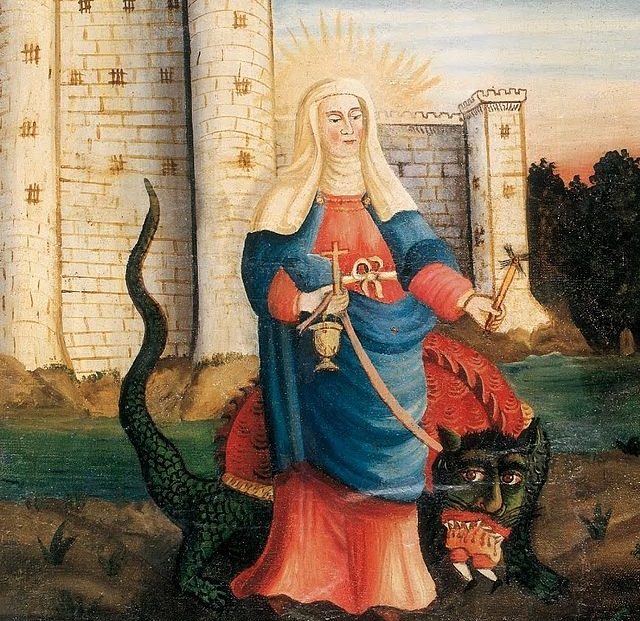This article originally appeared in the July 1999 issue of U.S. Catholic.
One day a man named Macarius quit climbing the corporate ladder and retired to the desert. Yet giving up the rat race didn’t eliminate rats from his life: “The heart is but a small vessel, and yet dragons and lions are there,” he wrote. “and there are poisonous creatures and all the treasures of wickedness; rough, uneven paths are there, and gaping chasms. There also is God, there are the angels, there life and the kingdom.”
Life is never dragon-free, whether in the fourth century of Saint Macarius or the 21st. How comforting that saint-archetypes can guide amateur dragon-dodgers through the Forest Perilous of modern life!
In my late, unlamented, purist days, I snubbed dragon-slaying saints of legend such as Saint George. After all, these figures—more folktale than fact—had been stricken from the leaner, fantasy-free post-Vatican II calendar.
Today, my favorite legendary “warrior princess” next to Xena is Saint Martha. With a respectful nod to Saint George, I relate to “dragon lady” Martha best. (Takes one to know one, I guess.)
Why Martha? I like her Amazon approach to life’s problems. Who doesn’t secretly sympathize when Martha complains that Mary should be cookin,’ not schmoozin’? And at Lazarus’s tomb, reproachful, hands-on-hips Martha merely voices what people often think but rarely say, “Lord, if you had been here, my brother would not have died.”
Medieval legend embroidered scripture’s portrait of a bustling, no-nonsense woman. After Jesus’ death, Martha, Mary Magdalene, and Lazarus were said to have sailed off to evangelize France. Landing at Marseilles, Martha squelched a dragon by sprinkling him with holy water—a good home remedy for evil—lassoing him with her belt, and leading him off to the nearest dragon depository. She also invented bouillabaisse in her spare time.
A friend of mine holds a yearly Martha Party on the feast-day of July 29. Guests are given a Martha booklet packed with information on the saint: legends, poems, illustrations, scripture, symbols, modern commentaries, old prayers, and novenas. Martha’s popularity in traditional Mexican American devotion makes her image common in Texas, and the party centerpiece is the Martha Shrine: a statue of Martha brandishing a broom, the Bible, and an incense-burner. A dragon curls meekly at her feet.
As for my own Martha statue, it guards my desk at work and has been smuggled into many a contentious staff meeting.
Why such a literal application of folktale metaphors to life? The book Well-Intentioned Dragons by Marshall Shelley (Bethany House, 1999) explains, “Dragons, of course, are fictional beasts—monstrous reptiles with lion’s claws, a serpent’s tail, bat wings, and scaly skin…But there are dragons of a different sort, decidedly real. They do not intend to be sinister, but their charm belies their power to destroy. They leave ulcers, strained relationships, and hard feelings in their wake. Often they are pillars of the community…Sightings of these dragons are all too common. As one veteran pastor says, ‘Anyone who’s been in ministry more than an hour and a half knows the wrath of a dragon,’”
Though targeted at church ministers, the people and problems described in Well-Intentioned Dragons are just as common in secular workplaces. Who you gonna call? Saint Martha.
The medieval storybook The Golden Legend says that Martha’s dragon felled its foes with its own flaming dung. What better patron saint for those sticky staff meetings when the you-know-what hits the fan? Or consider the yearly Saint Martha River Festival held in Pateros, Philippines. In the Pateros River procession, a replica crocodile follows a barge carrying Martha, whose miraculous intercession saved the town’s duck-egg industry from the scaly saboteur. Who better to combat the “crocodile tears” of our crafty opponents than Martha?
When stress stokes my own dragon flames, Martha is a talisman reminding me that all our sinful dragon natures are tamed and transformed by sacramental waters. Well-Intentioned Dragons warns: “When attacked by a dragon, do not become one. If I become a beast in order to fight a beast, all that reigns is beastliness.”
Martha’s traditional symbols are the ladle, broom, holy water, and dragon. In my own statue Martha brandishes a torch and clasps a Bible as a spiritual weed-whacker and a caregiver. Martha and Mary are the two aspects of life we must balance: the exterior and the interior.
May all your well-intentioned dragons be toothless. If not, I’ve got a teeny dragon-slayer I can loan you.
Image: Wikimedia Commons













Add comment